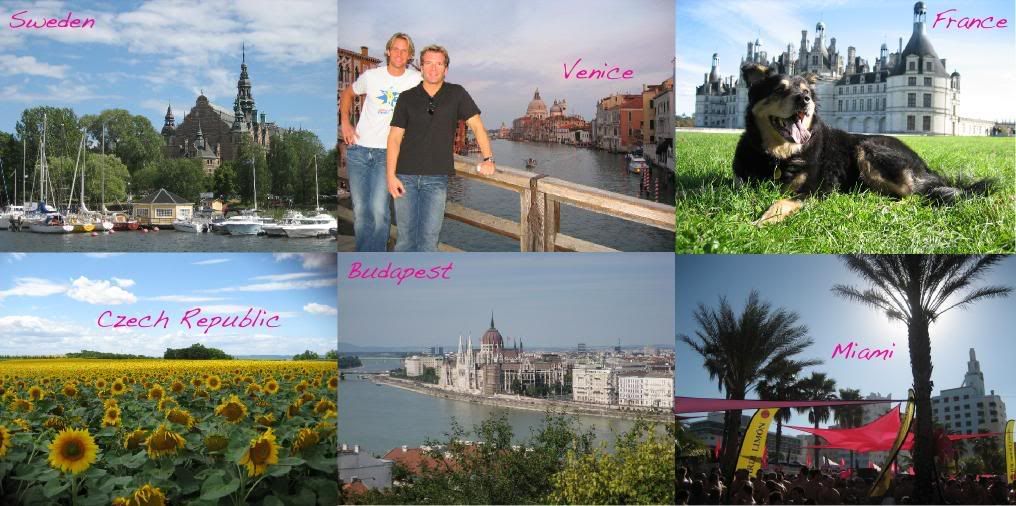More Nooz on Chris
If you want to know what Chris has been working on since moving to Europe, check out an article that highlights one of his projects - his biggest to date. Below is an article that appeared in the Morgenavisen Jyllands-Posten in Denmark. It's all about Chris' new burger, the "M" burger. Pay close attention to the journalists reference to Chris' "infectious smile" and "modern day manager" techniques.
MUNICH
Good Lord, a bun, a beef patty, some lettuce and some dressing; how difficult can it be?
Apparently rather difficult. Scientists from the famous American burger chain, McDonald’s, have spent three years inventing a new burger in a food laboratory in Munich.
Undeniably, some will not think so when the result is still just a beef patty, bun, lettuce and dressing.
The hamburger industry has been blamed for much in the course of time – from being the cause of the global wave of obesity to cheating with the photos on the menus and reducing children and youngsters to stupidity after having taken their money in exchange for an unhealthy lifestyle. But they have never been accused of being slow. Quite simply, slowness is not part of the register of allegations. Restaurants in countries like Mexico even promise self-punishment if it takes more than 90 seconds to serve the burger.
Three good reasons
M, the new burger, has been developed, fostered and computed in every respect. And there’s good reason for this.
I was invited to one of the global burger dominator’s three development laboratories, i.e. the one in Munich – the other two are located in Hong Kong and in Chicago – to hear the reasons.
In a fashionable office building on the outskirts of the German metropolis, the founders' portraits hang on the wall in the reception area next to black and white photos of their successors and the German directors.
The man-sized plastic mascot, Ronald McDonald, sits with legs crossed on a bench. The words “Ich liebe es”, the burger chain’s German motto, hang above him.
Customers’ wished-for burger
In the basement is the laboratory with clinically clean kitchens, freezers, test grill bars, quality control room, etc. The development department’s senior director, Chris Young, is proud of the result of the scientists’ work.
“Launching a new burger is not something you do from one day to the next. One thing is having the production lines ready to be able to handle the demand of hundreds of millions of burgers. Another consideration is: What should the burger be like? To find the answer, we listened to the customers. M is the fulfilment of their wishes,” says American, Chris Young.
His smile is infectious. Chris Young is the modern manager type, ready to answer openly and honestly, even about negative topics.
For instance, the burger chain made a big mistake when some years ago they developed a burger; it turned out that employees at McDonald’s restaurants around the world generally did not like it and therefore did not like to sell it. The burger was discontinued. This side of the matter also has to be considered.
Behind Chris Young is a team of elite burger makers. They make M’s for the pack of international journalists who have flown in for the world premier.
“We have the second and third generation of McDonald’s burger consumers. The world has become smaller. Everyone travels more and it has become more difficult to impress. Customers want quality. Our response is to change our profile to be more complex and braver,” says Chris Young.
A thicker beef patty
The M burgers arrive.
The minced beef in M is specially developed, so the consistency resembles a steak. The flavour is strong, grilled barbeque and juice from the meat trickles out when you take a bite. The bun is oblong and baked in a stone oven. The lettuce is a thick layer of whole Batavia leaves, the strong lettuce, which many farmers had to be convinced to begin cultivating.
In order to find the final configuration, the Irish head chef, Adrian Coulter, tested 20 new types of burgers on trial consumers, narrowed the field down to 10 and then 4. After further research, the five criteria for M were reached.
“Top priority was given to the beef patty, which had to be thicker and tastier than our current beef patties. Then came the bread, which had to radiate quality and have a rustic appearance. We ended up developing a bun like ciabatta bread. Priority three was the cheese. The demand was to develop rich-flavoured, irregular slices that stick out of the sides of the burger and melt without running. The choice fell on Swiss cheese. The lettuce had to radiate health, be curly and abundant. The final priority was the dressing, which as opposed to the lettuce had to be subtle and not dominate the overall taste impression,” says the head chef.
It’s an old wives’ tale that McDonald’s food must be the same all over the world. However, Chris Young admits that in the US a bit more salt, sugar, pepper and dressing are added to the burger, but otherwise there are set standards.
The food technology engineer, Sabine Schulze tells more about this.
Model/designer products
“Suppliers of cheese, ketchup, buns, lettuce, pickles, hamburgers, milkshakes and so on from around the world send samples to us every month. Using schemas, we investigate whether the products live up to the standards and parallel to this, every year we appoint a trend or model product to which all the others are compared. This applies to colour, consistency, flavour, appearance, form and reaction during preparation,” explains Sabine Schulze.
“We even warm up the frying oil to 60 degrees and taste it.”
This year, the arch-pickle comes from Germany, the world’s best McDonald’s mustard is American, the model ketchup is from Nagano in Japan, Korea sets the standard for the bread, the meat is Italian, the model chickens come from Vejle, the fish fillet, which others have to live up to comes from Espersen on Bornholm – have all supplied McDonald’s for 40 years – whilst the template for bacon is from Thisted.
Home once again on the same evening, I conduct my own test. I buy an M at the Central Station in Copenhagen. I eat it.
It was no bluff. It bulges with lettuce. The juice from the meat runs down my sweater again. The bread does not get stuck to the roof of my mouth.
My, oh my, what’s happening?
Facts: McDonald's
The name McDonald's originates from Dick and Mac McDonald, two brothers who opened a restaurant in California in 1940 and invented the modern fast-food concept.
In 1955, Ray Kroc opened the ninth McDonald’s restaurant in a row, but ended up buying out the brothers entirely.
In the 1960’s the global expansion began.
Today, McDonald’s has 1.5 million employees worldwide, of which 4,000 are in Denmark.
There are 31,000 McDonald’s restaurants in 119 countries around the world. Everything is tested by two anonymous test consumers every month.
McDonald’s has 160,000 customers in Denmark per day, 50 million per year.
* Thoroughness and plenty of tests characterise the work when a new McDonald’s burger is to be launched.
* To begin with, M is a promotion burger, which is only sold for a limited period after which it will be evaluated whether it should be included permanently in the range.







<< Home